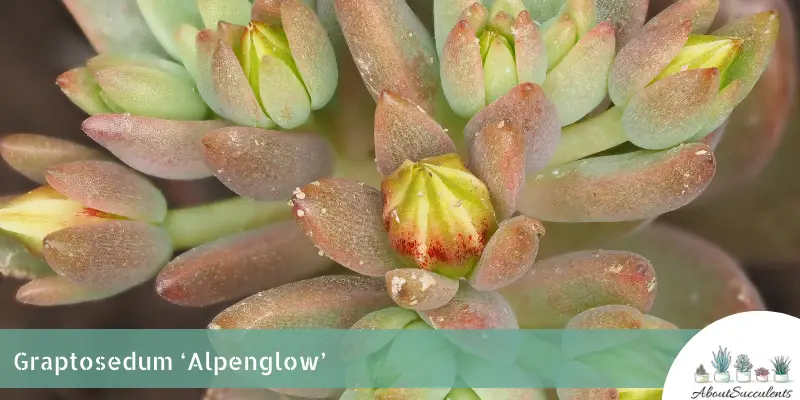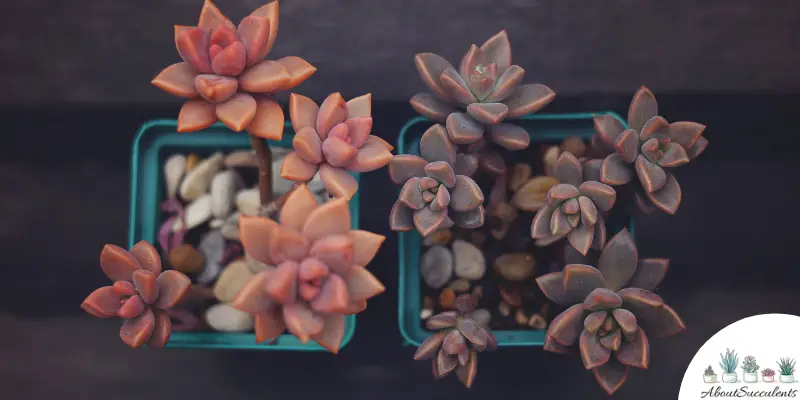
Graptopetalum “Alpenglow” is a charming succulent that will surely bring a smile to the faces of people who see it.
A hybrid of Graptopetalum and Sedum, Alpenglow will also bring relief to those who are welcomed by its countenance when they get home because its primary color of Pink is a symbol of hope.
Alpenglow has another alias that’s based on what people associate its tight, compact, pink-colored rosettes with – a pink sunset. The alternate alias is “Twilight”.
The leaves of Alpenglow are quite fleshy and have an arrow-like shape. Before they turn pink, the leaves start out light green and take on different iterations of the color green as the plant matures.
The stems have a light brown color and are marked by scars. The rosettes grow and form along the stem. Over time, the rosettes spread out and become ground cover.
In the spring, look out for small, star-shaped, yellow-colored flowers that bloom along the sides of the stems. While not particularly beautiful, the flowers lend an aesthetic appeal that complements the overall allure of Twilight.
Graptosedum Alpenglow is native to Mexico and is a member of the Crassulaceae family. It can grow to a height of 8-inches (20cm) with a width of 12-inches (30.5cm).
General Information
Also known as: Alpenglow, Twilight
Plant Family: Crassulaceae
Origin: Mexico
Height: 9-feet (274.32cm)
Exposure: Partial to full sunlight for up to 6 hours every day
Water Needs: Drought-tolerant; follow the Soak and Dry method for watering
Soil Type: Cactus mix or succulent soil then add 50% perlite, pumice, coarse sand, and lava rock for better drainage.
Soil pH: 6.6 to 7.5
How to Grow and Care for Graptosedum Alpenglow

There’s no question that its eye-catching color and shape are the reasons why people want Graptosedum Alpenglow inside their homes or their outdoor gardens.
Lesser-known reasons are that it serves as wonderful ground cover, the species is easy to propagate, and Alpenglow is one of the most durable succulent plants out there.
With all of these benefits of having Twilight in your home, add to the list it’s a type of succulent that’s easy to grow and care for.
Sunlight
You can grow Alpenglow in an outdoor garden, in container baskets, and indoors. The most important thing to keep in mind is to give the succulent its daily dose of the sun’s rays.
If you don’t, the leaves will etiolate or stretch out as if searching for sunlight, then wither and die.
When you’re looking to set up a rock or succulent garden in your backyard, make sure Alpenglow is situated in an area where it can receive 6 hours of partial to full sunlight every day. Full sunlight would be better so that Twilight can achieve its maximum colors.
However, avoid the rays of the afternoon sun at all costs as these will burn Graptosedum Alpenglow’s leaves. What you can do is plant Alpenglow in a pot and expose it to direct morning sunlight for a few hours before moving the pot to an area with partial shade.
Growing Alpenglow in a pot is a good idea if temperatures in your region drop below 30° F (-1.1° C) because as durable as the succulent is, it’s not cold-hardy.
Once indoors, place the pot near a window that gets 4 to 6 hours of partial sunlight every day. A better option would be to put Twilight under a Grow Light.
Watering
Graptosedum Alpenglow stores water in its leaves and stems. This ability allows Twilight to survive long periods of drought.
If you’re planning a month-long vacation, just water Twilight before you go to the airport. Graptosedum will just be fine.
Remember this rule – it’s better to give succulents less water than to overwater them.
Unlike sunlight, succulent plants don’t need everyday or frequent watering. Doing so will put Alpenglow’s health at risk because soil that stays moist for a long time becomes an ideal breeding ground for fungus.
The roots of Twilight will rot if immersed in a moist environment. Once the roots have turned bad and fungus has developed, your plant will be in trouble.
The best method for watering Alpenglow is the “Soak and Dry” approach – give the soil a thorough soaking only after it has completely dried out.
You can easily check the soil’s level of dryness by sticking your finger an inch deep. Does it feel dry? If yes, the soil can receive a good amount of water. You can also use a stick if you don’t want to get your finger dirty.
In the spring and summer months, expect to water the soil every seven to 10 days. However, during the colder months, the soil will stay moist longer. Watering the soil once a month will be just fine.
Pot and Soil
“How do I remove excess moisture from the soil?” is the same question you need to answer when you’re choosing the best pot and soil for Graptosedum Alpenglow.
The best answer for the type of pot is one that’s made of either unglazed ceramic or terracotta. These pots are composed of substances that not only support soil aeration but expedite the evaporation of water from the soil.
The size of the pot is another consideration. Buy a pot that’s slightly larger than the base of Alpenglow because as it grows, you don’t want the roots to get tangled up.
Remember – only slightly larger. If the pot is too big, that means you need more soil. And more soil means more water.
Before paying for the pot, check its bottom. A succulent pot must have a drain hole that allows excess water to spill out. When you see this happen, stop watering the soil.
Speaking of soil, Twilight will thrive in well-draining cactus soil or potting mix with added gritty materials to improve drainage. You can include 50% perlite, pumice, coarse sand, or lava rock.
How to Propagate Graptosedum Alpenglow
Graptosedum Alpenglow can multiply easily by using any of the 4 following methods for propagation: Cuttings, leaves, offsets, and seeds.
Cuttings Method
Step 1: Choose a healthy stem and cut a small section with a sharpened and sterilized knife.
Step 2: Set aside the stem cuttings and let them develop calluses over a period of 2 to 4 days.
Step 3: Place the calloused stem cuttings on a pot filled with well-draining soil.
Step 4: Lightly water the soil and position the pot near a window that gets 4 to 6 hours of partial sunlight per day.
Step 5: Observe the development of roots. When the roots have taken hold in the soil, follow the “Soak and Dry” method for watering.
Leaves Method
Step 1: Perform a clean and pull on a healthy leaf that’s growing near the stem. Twist the leaf and gently pull it off the stem. If a part of the leaf remains on the stem, you must repeat the procedure.
Step 2: Allow the leaves to form calluses. This process might take 2 to 4 days.
Step 3: Place the leaves on well-draining soil and spray it with water.
Step 4: Situate the pot near a window that receives up to 6 hours of sunlight every day.
Step 5: Back off the watering schedule once the roots have formed. Shift to the “Soak and Dry” method.
Offsets Method
Step 1: Alpenglow produces offsets from its rosettes. Use a sterilized and sharpened knife to remove the offsets from the stems.
Step 2: Give the offsets up to 4 days to grow calluses.
Step 3: Plant the calloused offsets in well-draining succulent soil.
Step 4: Water the soil lightly and place the pot near a window that can assure you of 4 to 6 hours of partial sunlight.
Step 5: Only water the soil when it’s 100% dry if the roots have fully formed.
Seeds Method
Step 1: Plant the seeds in well-draining soil only when temperatures are warm.
Step 2: Lightly water the soil and put the pot under a Grow Light or on a Seed Mat.
Step 3: Water the soil only sparingly once the roots have formed.
Frequently Asked Questions
Is Graptosedum Alpenglow Toxic to Cats and Dogs?
Graptosedum Alpenglow doesn’t appear in the list of plants that are toxic to cats and dogs found on the website of the American Society for the Prevention of Cruelty to Animals (ASPCA).
Why Is My Graptosedum Alpenglow Dying?
Graptosedum Alpenglow’s health can be seriously affected by overwatering and pest infestation.
You can bring Twilight back to the pink of health by following our tips outlined below.
Overwatering
Look for signs of infection such as discoloration on the leaves. Get a pair of sterilized and sharpened garden shears or a knife and remove these infected sections right away to stop the infection from spreading.
Once these infected sections are removed, do the same with the roots. While Twilight is resting, prepare a new pot with fresh cactus soil.
Repot Alpenglow but don’t water it right away. Wait for 2 to 3 days to give Alpenglow time to adjust to its new home.
Pest Infestation
Mealybugs, aphids, and scale insects will make Alpenglow’s leaves their new home and food source. These pests will help themselves to the succulent’s sap and then leave white, waxy substances on the leaves that can become infectious.
Remove the substances with a mild fungicide or a cotton ball that’s been soaked in 70% isopropyl alcohol. Then, spray the plant with diluted neem oil to keep the pests away.
Yes, Graptosedum Alpenglow produces small, star-shaped, and yellow-colored flowers in the springtime.
Last Updated on June 9, 2022 by Sofia Lara